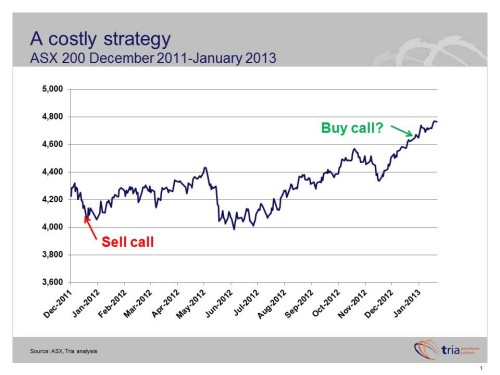How much did the SMSF gurus cost investors in 2012?
It’s easy to take potshots at the collective funds segment of the super industry. It’s big, a lot of money is at stake, and it’s relatively transparent. It’s easy to tell who is doing well and who is not.
Prominent amongst those taking the potshots are proponents of SMSFs, a competing solution to collective funds (and a lucrative one for many of those proponents). This makes for a difficult debate based on real evidence, because SMSFs are opaque. It’s hard to tell how they are performing, and what little data is available tends to be incomplete or apples vs oranges.
It’s even harder to compare the performance of SMSF investment gurus against the CIOs of collective funds. CIOs have unit price or return histories which can be easily compared against benchmarks. But there are no audited track records of SMSF guru recommendations to support their criticisms of collective funds performance.
So we’ve had a go at assessing how one prominent SMSF guru (also a vocal critic of collective funds) performed in 2012:
– In late 2011, our guru made a big sell call on equities, predicting a major sell-off. At this date the ASX 200 was around 4,060. The intent was to sell equities down significantly, or get out of the market completely.
– Investors following this would have sold retail favourites like banks and Telstra, yielding 6-9% (plus franking credits), for cash yielding about 4% (unfranked). Less transaction costs and CGT of course. That’s a cut in income of around a third to a half.
– In early 2012, the sell call was clarified to a halving of equity allocations, with remaining equities having a bias to the resources sector. Basically no banks, Telstra, AREITs, or other high yield stocks.
– From March through to October, with the market rising through 4,500, the steadfast call was for the bear market to continue and indeed for the ASX 200 to fall to new lows.
– But cracks started to appeared. By June it was conceded that a resources bias in the equity allocation was a bad idea.
– By October, another concession that the view may have been too bearish, although there still no call for investors to restore their equity weightings.
– Finally, Christmas 2012 saw the towel thrown in, with a concession that not only the gloom had been overdone, but also that 2013 should be a great year for shares.
Can we compare 2012 returns? Not easy, but we have had a go, accepting that estimates will be very approximate and should be taken with a large dose of salt:
– Balanced super defaults typically returned 13-14% after tax in 2012, which implies ~15% pre-tax.
– The guru strategy for 2012 appears to have been 30% Australian equities / 70% cash. Australian shares produced 20.3% in 2012 (plus franking credits). Online bank accounts (according to the RBA) started the year at 4.35% pa and ended at 3.05% pa. Let’s say 3.6% pa as an average.
– We estimate that the guru strategy would have delivered ~8.6% pre-tax, if the equity component achieved ASX200 returns. In fact that might be generous because it assumes ASX 200 returns on the equity component. A strategy of being long resources, and short high yield stocks, may have underperformed. But it could have been a bit either way of course.
All in all, the guru strategy likely underperformed the typical collective fund CIO significantly in 2012 – perhaps by ~650 bps. And not only would any investors following it potentially have sold low and bought high, they may sacrificed yields which are no longer available. You can’t buy Telstra on an 8.5% yield anymore, it’s now down to 6%.
The (unsurprising) conclusion is that in general, SMSF gurus have no special insights. While they have some good years, 2012 shows that they are just as capable of producing poor investment outcomes for those who follow them (by definition, mostly ex-members of collective funds).
It also provides more support for the view that SMSF members could benefit greatly if there were better, more readily accessible SMSF offers available from the big players in super and investment.

